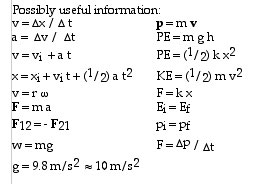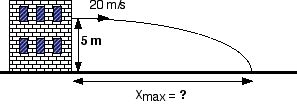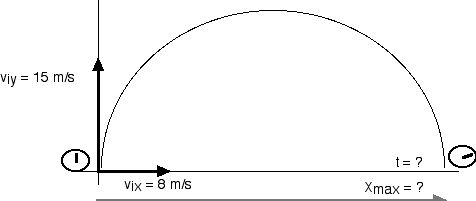

Excursions in Physics
Second Hour Exam
March 5, 2003
![]()
| Back to Excursion's Calendar |
![]()

For every question, also consider as a possible answer
E) none of the above

14. For which position above does the ball on the end of the string have the
greatest gravitational potential energy?
A) position A
15. For which position above does the ball on the end of the string have the
greatest kinetic energy?
D) position D
16. A 3 kg mass is held 4 m above the ground. What is the approximate potential
energy of the mass with respect to the ground?
A) 8 J
B) 40 J
C) 80 J
D) 120 J;
PE = mgh; PE = (3 kg)(4 m)(10 m/s/s); PE = (3)(4)(10) J; PE = 120 J
17. One car moves 3 times as fast as another identical car. Compared to the
slower car, the faster car has
A) the same kinetic energy
B) 3 times the kinetic energy
C) 9 times the kinetic energy;
KE = (1/2) m v2
D) 27 times the kinetic energy
18. A car moving at 50 km/hr skids 20 m with locked brakes. How far will the
car skid with locked brakes if it is traveling at 150 km/hr?
A) 40 m
B) 60 m
C) 90 m
D) 180 m
19. When a rifle is fired it recoils so both the bullet and rifle are set in
motion. The rifle and bullet ideally acquire equal but opposite amounts of
A) momentum
B) kinetic energy
C) velocity
D) all of the above
20. What does an object have when moving that it doesn`t have when at rest?
A) momentum
B) energy
C) mass
D) all of the above
21. If an object has kinetic energy, then it also must have
A) momentum
B) velocity
C) speed
D) all of the above
22. Horses that move with the fastest linear speed on a merry-go-round
are located
A) nearer to the center
B) nearer to the edge
C) always white (I like this one!)
D) in front of the slower ones
23. An industrial flywheel has a greater rotational inertia
when most of its mass is
A) nearer the axis
B) nearer the rim
C) spread out evenly
24. A cylinder and a ring roll down an incline
starting at the same time. The one to reach the bottom first
will be the
A) cylinder;
the cylinder has a smaller rotational mass, or a smaller
moment of intertia, so it is easier to rotate.
B) ring
C) neither; they both reach the bottom at the same time
25. When a twirling ice skater extends her arms outward, her
rotational speed
A) increases
B) decreases;
Since her angular momentum is conserved, and
increase in rotational mass requires a decrease
in rotational speed.
C) remains the same (or is conserved)
26. Kepler’s Laws of Planetary Motion were “discovered” or produced
by Johannes Kepler, using a lifetime of observational data taken by
A) Nicholas Copernicus
B) Galileo
C) Tycho Brahe
D) Isaac Newton
27. According to Kepler's Laws of Planetary Motion, the paths of planets about
the Sun are
A) straight lines
B) parabolas
C) ellipses
D) hyperbolas
28. According to Kepler’s Laws of Planetary Motion, as a planet gets closer
to the Sun,
A) it becomes warmer.
B) its speed increases.
C) its period increases.
D) its mass decreases.
29. According to Newton, the greater the masses of interacting objects, the
A) greater the force of gravity, by the product
of the masses
B) less the force of gravity
C) greater the force of gravity, by the square of the masses
D) less the force of gravity, inversely as the square of the masses
30. According to Newton, the greater the distance between masses of interacting
objects, the
A) greater the force of gravity, proportional to the distance
B) less the force of gravity, inversely
as the distance
C) greater the force of gravity, proportional to the square of the distance
D) less the force of gravity, inversely as the square
of the distance
31. What is the force of gravity on a 80-kg man standing on Earth's surface?
A) 9.8 N
B) 80 N
C) 800 N;
w = m g; w = (80 kg)(10 m/s/s); w = (80)(10) N
D) 8,000 N
32. If the radius of Earth somehow increased with no change
in mass, your weight would
A) increase
B) decrease
C) stay the same
33. If Earth's mass decreased to one-half its
original mass with no change in radius, then your weight would
A) decrease to one-quarter its original value
B) decrease to one-half its original value
C) remain the same
D) increase to twice its original value
34. The force of gravity acting on the Space Shuttle in orbit is nearly
A) zero because it is weightless
B) equal to the weight of
the Space Shuttle at Earth’s surface
C) about one-tenth its weight at Earth’s surface
D) about one percent of its weight at Earth’s surface
35. A woman who normally weighs 400 N stands on top of a very tall ladder so
she is one Earth radius above Earth's surface. How much would she weigh there?
A) zero
B) 100 N
C) 200 N
D) 400 N
36 The force of gravity acts on all apples on an apple tree. Some apples are
twice as far from the ground as others. These twice-as-high apples, for the
same mass, have practically
A) one-fourth the weight
B) one-half the weight
C) the same weight;
their distances from the center of Earth are all practically the same.
D) twice the weight
37. The planet Jupiter is about 300 times as massive as Earth, yet on its surface
you would weigh only about 3 times as much. This is because
A) your mass is 100 times less on Jupiter.
B) Jupiter is significantly farther from the sun.
C) Jupiter's radius is 10 times Earth's radius.
D) you are 100 times more weightless there.
38. The period for the Space Shuttle, or any other satellite in a low-Earth
orbit, is about
a) 17 minutes.
b) an hour and a half.
c) 24 hours.
d) 28 days.
39. Communications satellites are often placed in geosynchronous orbits. The
radius of a geosynchronous orbit is about
a) 500 to 600 km
b) 17,000 km
c) 42,000 km
d) 450,000 km
40. A car travels in a circle with constant speed. The net force on the car
is
a) directed forward, in the direction of travel.
b) directed towards the center of the curve.
c) zero because its speed remains constant.
d) directed outward, away from the center of the curve.
41. The moon travels in a nearly circular orbit at a nearly constant speed.
a) The acceleration of gravity on the moon’s surface is about one-sixth
the value at Earth’s surface.
b) The force of gravity between Earth and the moon provides the centripetal
force necessary to keep the moon in its orbit.
c) The force of gravity causes the moon to “fall” one-twentieth of
an inch each second toward Earth when compared to the straight line path it
would take if gravity were suddenly turned “off”.
d) all of the above.
42. Projectile motion is a combination of
a) horizontal motion with constant, non-zero acceleration and vertical motion
with constant velocity
b) horizontal motion with constant non-zero acceleration and vertical motion
with constant, non-zero acceleration
c) horizontal motion with constant velocity and
vertical motion with constant, non-zero acceleration
d) horizontal motion with constant velocity and vertical motion with constant
velocity
43. When a ball or stone or other object is thrown or hit or fired, and air
resistance can be neglected, the resulting motion is known as projectile motion.
The path of an object in projectile motion is
a) a quadrant of a circle
b) a hyperbola
c) a parabola
d) a straight line

44. Consider a ball thrown horizontally from the edge of a balcony
with an initial velocity of 20 m/s. The ball is thrown from 5 m above the
ground. How long is it in the air? That is, when does it strike
the ground?
a) 0.5 s
b) 1.0 s
c) 1.5 sy = (1/2) g t2
5 m = (1/2) (10 m/s/s)(t2)
1 s2 = t2
t = 1 s
45. Consider a ball that is thrown horizontally from the edge
of a building with an initial velocity of 20 m/s. The ball is thrown from 5
m above the ground. How far from the building does the ball strike
the ground?
a) 5 m
b) 10 m
c) 15 m
d) 20 m
; x = vx t; x = (20 m/s)(1 s); x = 20 m

46. Consider a ball thrown from a level surface with an initial upward velocity
of 20 m/s and an initial horizontal velocity of 5 m/s. How long
is the ball in the air?
a) 0.5 s
b) 1.0 s
c) 2.0 s
d) 4.0 s
When the ball returns to the level surface, vy = - viy = - 20 m/s
vy = viy + ay t
vy = 20 m/s + ( - 10 m/s/s) t
- 20 m/s = 20 m/s - (10 m/s/s) t
- 40 m/s = - (10 m/s/s) t
4 s = t
47. Consider a ball thrown from a level surface with an initial upward
velocity of 20 m/s and an initial horizontal velocity of 5 m/s. Where
does it land? That is, measured from its initial position, where does it come
back to and strike the level surface?
a) 5 m
b) 10 m
c) 15 m
d) 20 m
x = vx t
x = (5 m/s)(4 s)
x = 20 m

48. A golf ball is given a velocity of 8 m/s horizontally and 15 m/s vertically.
How long is it in the air, before coming back to its initial vertical
height? That is, how long is it in the air before striking the
level ground?
a) 1.5 s
b) 2.0 s
c) 3.0 s
As before, we can set vy = - viy
vy = - 15 m/s
vy = viy + ay t
vy = 15 m/s + ( - 10 m/s/s) t
- 15 m/s = 15 m/s + ( - 10 m/s/s) t
- 30 m/s = - (10 m/s/s) t
3 s = t
d) 4.0 s
49. A golf ball is given a velocity of 8 m/s horizontally and 15 m/s vertically.
How far, horizontally, does it travel before coming back to its
initial vertical height? That is, where does it hit the level
ground?
a) 8 m
b) 12 m
c) 24 m;
x = vx t; x = (8 m/s)(3 s); x = 24 m
d) 48 m
50. An object that has kinetic energy must be
A) elevated
B) falling
C) moving
D) at rest
![]()
| Back to Excursion's Calendar |
![]()